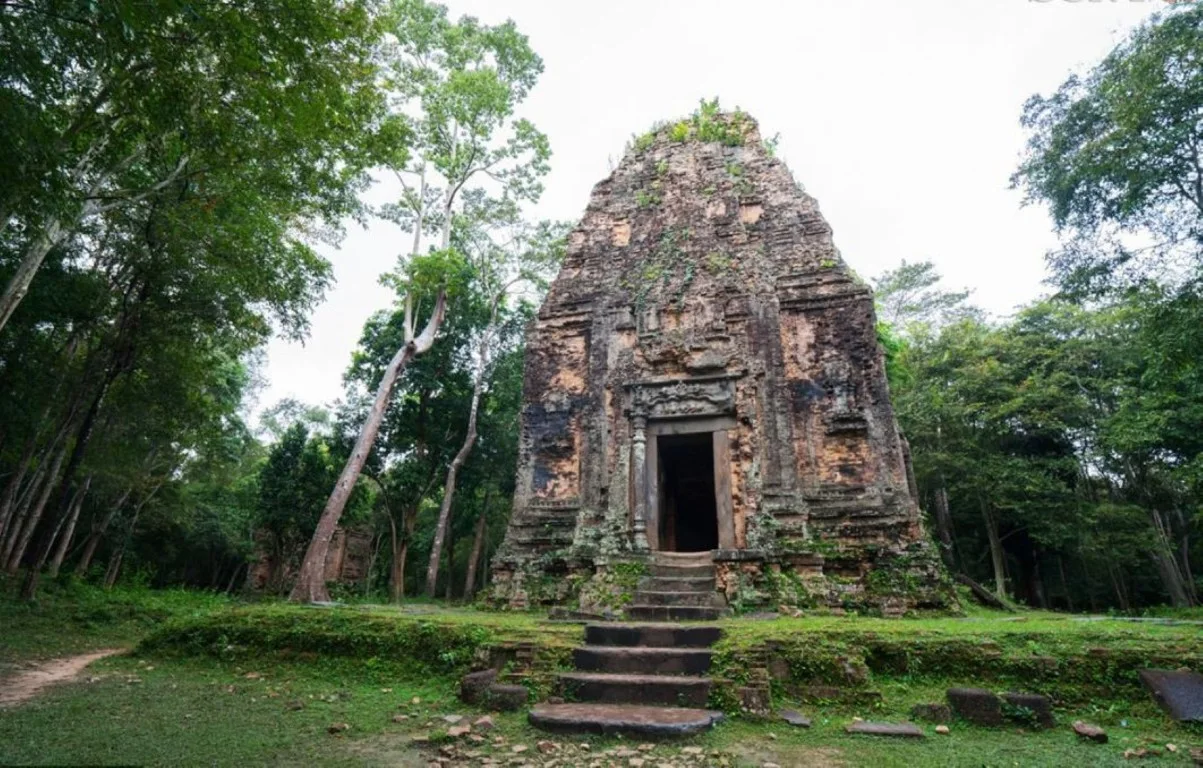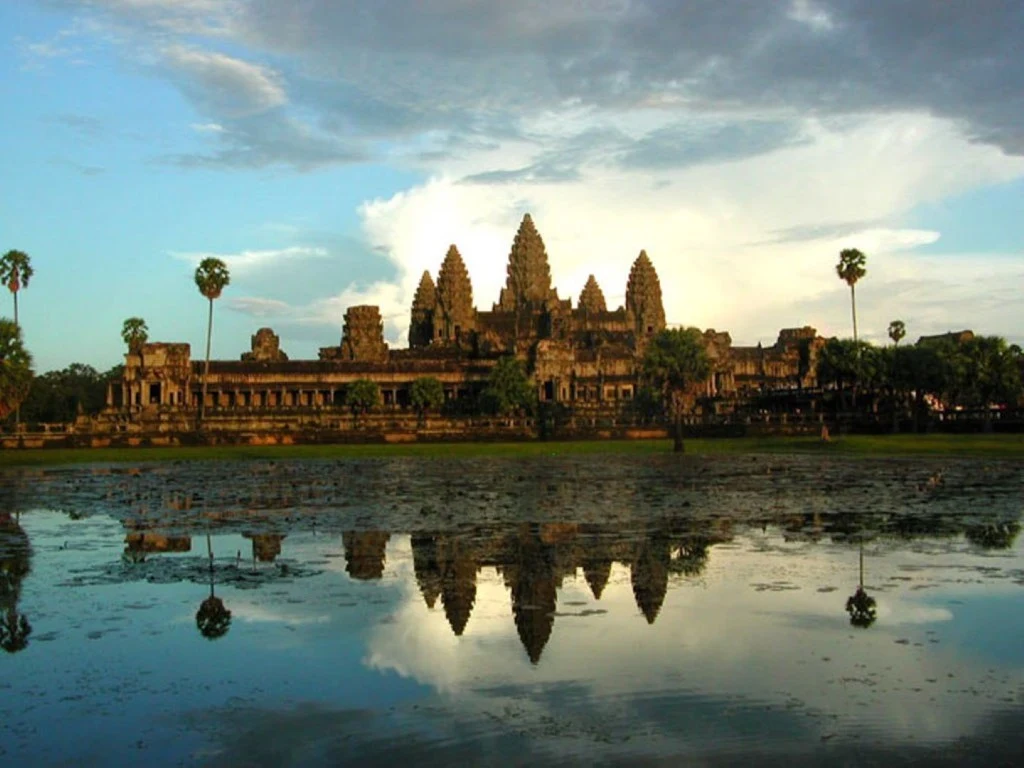Architecture is the art of building with proper decoration according to the rules.
Style refers to the art of building or decorating according to the king's ideas in building ancient temples. In ancient times, there were up to 13 separate styles, each with different construction and features according to each period.
1- Phnom Da Style (1st to 6th century BC)
Excavations in Angkor Borei and Okeo (Kampuchea Krom) have shown that Funan art was incorporated into the Phnom Da style, using the temple at Phnom Da as a base. Phnom Da is located near Angkor Borei in Takeo Province. During the Funan period, Cambodia had many contacts with India, especially in the field of art.
In addition to Khmer architecture, the Nokor Phnom period left many works inside the statues that were found at Angkor Borei and many other places in Cambodia. The excavations at O Keo have revealed the tools and jewelry that the Khmer people of that time used.
2-Phnom Da Style (first half of the 7th century AD)
The Sambo style was during the reign of King Isanvarman I (616-635 AD), with the capital at Isanpura, Sambo Prei Kuk (Kampong Thom Province). Many temples are included in the Sambo style, such as the Sambo Prei Kuk temple, almost all except the temple (in the Kulen style). The architectural style was built in the Sambo style and in many subsequent styles until the 10th century AD. The temples were small in shape, made of Phnom Da, with mortar made of sugar cane, but now they have almost completely collapsed, leaving only bare bricks.
The lintel and colonnelte are made of sandstone, and most of the temples are built in an irregular manner, one here and one there.
In this style, female statues are usually found, which are small, have a wide hips, and wear round crowns.
On the other hand, male statues are mostly large and strong.
3- Prey Kuk style (second half of the 7th century AD)
The Prey Kuk style dates back to the reign of King Jayavarman I (655-681 AD), whose capital was Angkor Borei. The temples included in this style include Prey Kuk Temple and Svay Brahma Temple (ancient part).
This architecture is similar to the architecture in the Sambo style, with the most common surface design being the Phạnh Thứ style, i.e. the Phạc Chân style. In this style, the Harihara of the Andet temple is often admired, which is considered a unique work in Khmer art because this statue shows that Khmer artists have high techniques by knowing how to make this statue into a very beautiful shape.
4- Kampong Preah style (8th century CE)
This style was in the Chenla period, which was divided into two. The temples included in this style are Kampong Preah Temple, Meak Yam Temple (ancient part), and Tran Nham Phong Temple (ancient part). In this style, almost all temples are built like in previous periods, namely flat and earthen, except for Ak Yam Temple, which is built in several floors, shaped like a pagoda.
The statues in this style are good, some are bad, but Khmer art has its own special development, namely, Khmer artists have tried to eliminate the bases and dams of some statues.
Khmer art during the Angkor period (9th-13th centuries AD) is divided into 9 styles:
5- Kulen style (mid-1st century AD - 9th century AD)
This style was during the reign of King Jayavarman II (802-850 AD) who built capitals in many places. The temples included in the style include Prasat Preah Basat, Prasat Phnom Kulen, Prasat Domrey Krap, Prasat Obang, Prasat Khting Tham.
King Jayavarman II had lived in Java and during his reign he also established the Devaraja ceremony. Therefore, Khmer art also received some of these influences, which led to the construction of the Phnom temple, etc. In general, Khmer art during that period did not have many styles, but artists created many new features called the First Renaissance in the history of Khmer art.
As in the past, temples were still built of bricks, but they were often built on mountains to accommodate the Devaraja ceremony. This idea led to the emergence of many mountain temples (Temple Mentange) in later times.
6-Preah Ko Style (late 1st century BC–9th century AD)
The Preah Ko style was in the reigns of King Indravarman I (877-889) and King Yasovarman I (889-900 AD), who initially lived in the capital of Hariharalaya, in Roluos, Siem Reap Province. The temples included in the Preah Ko style are Prasat Preah Ko (879 AD) and Prasat Bakong (881 AD), which were built by King Indravarman I.
As for Prasat Lale (893 AD), which is the work of King Indravarman I. In this era, they always built temples from bricks and mortar, but they built many temples on a single foundation (preah lale) to dedicate to ancestors, parents, etc.
In addition, they built the multi-story Phnom Bakong temple to house the linga of Preah Isora, and on the fourth floor of this temple, they tried to build 12 small temples from sandstone.
7- Bakheng style (late 9th century - early 10th century)
The Bakheng style dates back to the reign of King Yasovarman I (889-900 AD), whose capital was Yasodhapura (Mount Bakheng). The temples that were built in this style include Phnom Bakheng Temple, Phnom Krom Temple, Phnom Bok Temple, etc.
During this period, the statues were straight, large, and solid. The eyebrows were straight and connected, while the lips and cheeks were clearly carved into two circles. The hair and beard were carved together. These statues wore a pleated skirt around their bodies, with the upper part folded down.
8-Koh Ker style (10th century CE)
This style dates back to the reign of King Jayavarman IV (928-941 CE), who established his capital at Koh Ker, about 100 kilometers northeast of Angkor.
The temples included in this style are all of Koh Ker, and among these, one is a seven-story temple about 35 meters high. The statues are similar to those of previous periods, but many are large and have various movements, such as walking, dancing, or fighting (Sukrip and Pali) to show the power and energy of King Jayavarman IV, the king of Chrek.
9- Banteay Srei style (second half of the 10th century BC)
The Banteay Srei style dates back to the reign of King Rajindravarman (944-968 AD), who established his capital at Angkor. The temples include Mebon East Temple (952 AD), Pre Rup Temple (916 AD), and Banteay Srei Temple (967 AD).
According to some historical documents, Banteay Srei Temple was the temple of a Brahmin named Yajnavaraha. This temple is not a mountain temple, but a temple built in the best style of sculpture in the Khong Vong dynasty to this day. The statues are many, small in size, with gentle faces, thick and short lips, and a new hairstyle and no crown. These statues are dressed in pleated and loose-fitting robes.
10-Khlaeng style (late 10th century and first half of 11th century)
This style dates back to the reigns of King Jayavarman V (968-1001 CE) and King Suryavarman I (1002-1050 CE), who had their capital at Angkor. The Khlaeng style includes the temples of Takeo, Khlaeng North, and Vimean Akas.
As for the statues, they have gentle faces like those of the Banteay Srey period, only covered by long, pleated robes, and a new, different skirt is seen, the back of the skirt goes up to the back, while the front falls down, exposing the midriff.
11-Baphuon style (second half of the 11th century BC)
This style was in the reign of King Udayadityavarman II (1050-1066 AD) and King Harshavarman III (1066-1080 AD), who also had their capital at Angkor. The temples included in this style include Baphuon Temple, Mebon Temple, and Wat Khnar Temple.
In that period, the construction of Phnom Rit Temple further developed. Baphuon Temple has two-story pavilions, surrounded by sandstone roofs, and has towers on all sides of the pavilion and gopuras at the steps in all four directions.
In Baphuon Temple, there are story designs on the walls of the gopuras and the walls of the second-story corner towers. These story designs are divided into small panels, each with a rectangular shape. The rectangles and most of the stories are related to Vishnu, while the statues are no different from the Khleang style.
12-Angkor Wat style (first half of the 12th century BC)
The Angkor Wat style dates back to the reign of King Suryavarman II (1113-1145 AD), who had his capital at Angkor. The temples that were included in this style are Boeung Mae La Temple, Balilay Temple, Kompum Temple, Bakong Temple, etc.
In this style, Khmer architecture reached its peak. On the wall of the first floor, there are 8 large and long panels, and the panels have different stories.














